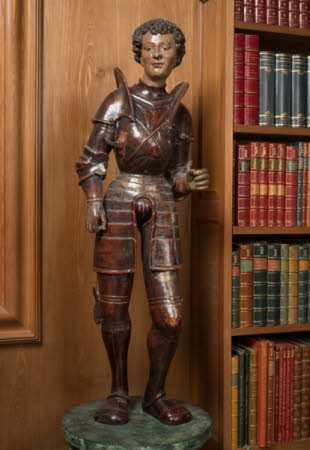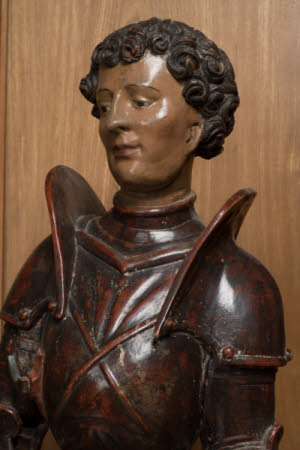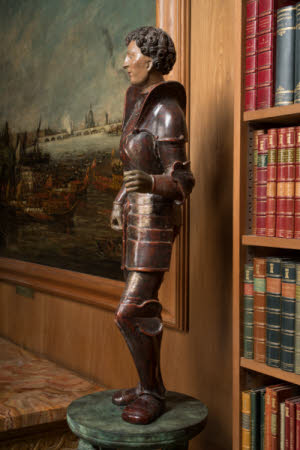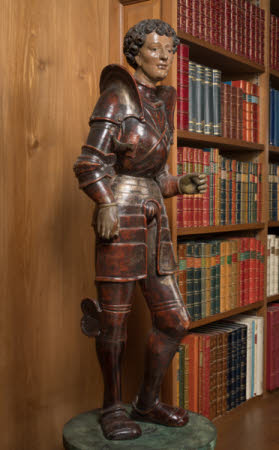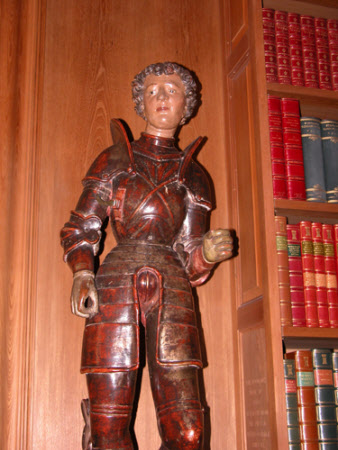Saint Florian, a guardian figure from an altar
German (Swabian) School
Category
Art / Sculpture
Date
c. 1510 - 1520
Materials
Polychromed silvered and gilt wood
Measurements
102 x 34 x 18 cm
Place of origin
Swabia
Order this imageCollection
Anglesey Abbey, Cambridgeshire
NT 514507.2
Summary
Polychromed silvered and gilt wood, St Florian, a guardian figure from an altarpiece, German (Swabian) School, c. 1510-20. A South German early 16th-century wooden sculpture of a warrior saint, probably Saint Florian, or perhaps Saint Eustace, or standing and looking to his right. Except for his uncovered head, he wears full armour with high pauldrons (shoulder pieces), and a rest for a jousting lance at the right side of the breastplate. An embossed Saint Andrew’s Cross on the breastplate. The sculpture made of wood, polychromed and silvered (the armour), with silver leaf applied to a red bole ground. Once held a lance, perhaps with a banner attached, in his left hand, and also originally held an object in his right hand. The parts of the sculpture visible from the front have been restored and overpainted; there are later painted floral patterns visible on the breastplate. Left hand to wrist may be a replacement. The hair has been re-gilded. Part of a buckle missing from back of left leg. The sculpture and its pair, Saint George (NT 514507.1), were made as guardian figures to stand either side of the central shrine of a large wooden altarpiece in a church.
Full description
The two figures of warrior saints were evidently made in the same workshop and must have once formed part of the same ensemble. Figures such as these were commonly placed in altarpieces, standing in niches and generally flanking the main image, thus functioning as guardians of the Holy figures depicted in the main shrine in the form of sculpted figures or on painted shutters. Although standing figures made for altarpieces are often either left unworked or only summarily worked at the back, these two figures are noteworthy for the degree of finish in all areas, including the back. This is because they would almost certainly have stood on pedestals on either side of the main shrine, an arrangement that can be seen in the High Altar of the parish church of Saint Wolfgang near Salzburg, made by Michael Pacher (active c. 1465, died 1498) and his workshop between 1471-81, with its two magnificent standing figures of Saint George and Saint Florian (Nicolò Rasmo, Michael Pacher, London 1971, figs. 82-83). The St Wolfgang Altar is one of very few Gothic altarpieces to remain intact and in its original location, so is important for showing how such figures functioned. In St Wolfgang, they stand on pilasters either side of the shrine, so that when the painted shutters of the altar are opened, the guardian figures are in fact concealed from the congregation. Like the Anglesey Abbey warrior saints, Pacher’s two saints are carved in the round, their armour meticulously described. Both of the Anglesey Abbey warrior saints would originally have held lances, matching the jousting armour they wear. The most impressive element of the figures is the remarkably accurate and detailed rendition of the armour, which is fully realised also at the backs, down to the fastening straps. The silvering of the armour would when fresh have given the figures a splendid aspect. The accurately-depicted armour helps to date the sculpture to c. 1510-20, the high vertical haute-pieces on the pauldrons (shoulder pieces) and high neck guards for example being typical of German armour from around this time. The recessing of the cross on the breastplate may be compared with the breastplate made for a Teutonic Knight around the same time, in the Rüstkammer, Dresden (Inv. M142). Similar styles of armour may be seen in the armoured figure of a knight in the drawing of A Knight and his Lady by Albrecht Dürer (1471-1528) in the Christ Church Picture Gallery, Oxford, of c. 1510 (Christopher White, Dürer. The Artist and his Drawings, second edition, Oxford 1981, pp. 132-33, no. 52) or in another drawing of a knight in armour by the Dutch artist Jan Swart in the British Museum, c. 1510-20 (Inv. PD 1871,1209.2067). The figures by Michael Pacher in St Wolfgang are among the finest examples of these South German or Austrian guardian figures. Another outstanding pair is the Saints George and Florian from the dismantled altar made by the Swabian sculptor Hans Multscher (c. 1400-1467) for the parish church of Sterzing (Vitipeno) in South Tirol, now in the Multscher-Museum in Sterzing (Erich Egg, Gotik in Tirol. Die Flügelaltare, Innsbruck 1985, pp. 76-82, Abb. 34; Ulrich Söding, Hans Multscher. Der Sterzinger Altar, Bozen 1991, esp. pp. 27-29, Abb. 25-32). Like the Anglesey Abbey and St Wolfgang saints, Multscher’s figures are carved in the round, with close attention paid to the details of the accurately depicted armour. Like the Anglesey Abbey saints, they are also depicted bare-headed. Another pair of Saints George and Florian wearing full armour, made in Tirol and dated c. 1500, is in the Skulpturensammlung of the Staatliche Museen, Berlin (Invs. 8181-82. Theodor Demmler, Staatliche Museen zu Berlin. Die Bildwerke des Deutschen Museums. III. Die Bildwerke in Holz, Stein und Ton. Grossplastik, Berlin and Leipzig 1930, pp. 279-80). The pose of the figure of Saint Florian is especially close to that of the second saint in the Anglesey Abbey pair. Yet another Tirolese pairing of George and Florian, datable to c. 1480, is in the Tiroler Landesmuseum Ferdinandeum in Innsbruck (Invs. P 1008, P 1009. 1500 circa: Leonardo e Paola, una coppia diseguale; De ludo globi, il gioco del mondo; Alle soglie dell'empero, exh. cat., Schloss Bruck, Lienz; Palazzo vescovile, Bressanone; Castel Beseno, Besenello, Milan 2000, p. 193, no. 1-18-9). The warrior saint depicted in this statue, unlike its companion figure of Saint George with its dragon, lacks an attribute and so is more difficult to identify. The most distinctive feature is the St Andrew’s Cross on the breastplate. This might suggest the saint as Eustace, a patron saint of hunters, who when out hunting met a stag with a crucifix between its antlers. A relevant image of Saint Eustace may be seen in an altarpiece by Albrecht Dürer (1471-1528), the Paumgartner Altarpiece, completed in 1503 and today in the Alte Pinakothek, Munich (Heinrich Müller, Albrecht Dürer. Waffen und Rüstungen, Berlin 2002, pp. 96-100, Abb. 92-93). In this triptych, the central panel with the Nativity is flanked by side panels containing the standing figures of Saints George and Eustace, the latter with a similar St Andrew’s cross on his breastplate and identifiable as Saint Eustace by the pennant banner at the end of his lance, with the stag’s head surmounted by the Crucifix. It is possible that the lance held by the Anglesey Abbey figure once sported a similar pennant. However, on balance, it is more likely that the figure is intended to represent another soldier saint, Saint Florian, who was most frequently paired with Saint George in paintings and sculptures made in the southern German speaking lands in the years around 1500. This is the pairing in the St Wolfgang and Sterzing Altar altars, as well as the pair of saints in the Tiroler Landesmuseum and the pair in Berlin. Saint Florian (c. 250-304 A.D.) was born in Austria and joined the Roman army, rising to the become a commander. Having converted to Christianity, he was accused of not persecuting the Christian believers in his district with enough severity and was ordered to sacrifice to the pagan gods, which he refused to do. Condemned to death by burning, Florian unnerved the soldiers who were tying him to the pyre, by challenging them to burn him and promising to welcome the flames. He was instead drowned in a river. As an officer in the Roman army, Florian assembled a squad of soldiers trained in firefighting, hence he became the patron saint of firefighters, whilst he was also invoked for protection against floods, blizzards and droughts. He is widely venerated in Southern Germany, Austria and Central Europe. In South German and Austrian art, Florian’s attribute invariably refers to his role in protection against fire. In another sculpture of the saint at Anglesey Abbey, made in Austria or Southern Germany around 1500 (NT 514476), he is depicted standing upon a hillock, atop which is a burning fortified church, onto which Florian pours water from a wooden bucket. Likewise, in Hans Multscher’s Saint Florian in Sterzing, the saint carries a small burning castle. Both the Anglesey Abbey warrior saint and the Saint Florian in the Tiroler Landesmuseum lack their attributes, but the fact that the former clearly once held some object in his right hand may provide the clue to his identification as Florian. The figures of Saint Florian in Berlin and in the St Wolfgang altar both hold in their right hand a small bucket or jug, from which water flows down onto a separately carved burning castle. It would seem probable therefore that the Anglesey Abbey figure originally held a jug or a fire bucket in his right hand from which he tipped a carved representation of water onto some separately carved burning building, all these attributes now lost. The sort of small bucket with a stick handle that the Anglesey Abbey sculpture would once have held can be seen in a number of surviving sculptures of the saint, including by an Ulm sculptor, c. 1520, in the museum in Grenoble (Inv. MG 1297. Sophie Guillot de Suduiraut, ed., Sculptures allemandes de la fine du Moyen Age dans les collections publiques françaises 1400-1530, exh. cat., Musée du Louvre, Paris 1991, pp. 226-28, no. 62), another made in Bavaria, c. 1500, sold at auction in 2006 (Property from 33 European private collections: Paintings, furniture and works of art, Sotheby’s Amsterdam, 21-22 February 2006, lot 186) and another sold at auction in 2015, by a sculptor in the circle of the South German sculptor Jörg Lederer (Old Master Sculpture & Works of Art, Sotheby’s London, 10 December 2015, lot 347). Jeremy Warren 2020
Provenance
Acquired by Huttleston Rogers Broughton, 1st Lord Fairhaven (1896-1966), between 1932 and 1940; listed in the Anglesey Abbey inventory of 1940, p. 152, The Library, valued at £50 the pair; bequeathed to the National Trust by Lord Fairhaven in 1966 with the house and the rest of its contents.
Credit line
Anglesey Abbey, The Fairhaven Collection (National Trust)
Makers and roles
German (Swabian) School, sculptor
References
'Anglesey Abbey, Lode, Cambridgeshire. An Inventory and Valuation of Furniture, Books, Ornamental Items & Household Effects .. prepared for Insurance Purposes’, Turner, Lord and Ransom, April 1940, p. 152. Christie, Manson & Woods 1971: The National Trust, Anglesey Abbey, Cambridge. Inventory: Furniture, Textiles, Porcelain, Bronzes, Sculpture and Garden Ornaments’, 1971, p. 149. Russell 2007: Joanna Russell, ‘Anglesey Abbey Sculpture Project’, Hamilton Kerr Institute, University of Cambridge, 2007, pp. 20-22, Pl. 6, Appendix, pp. 22-26.
